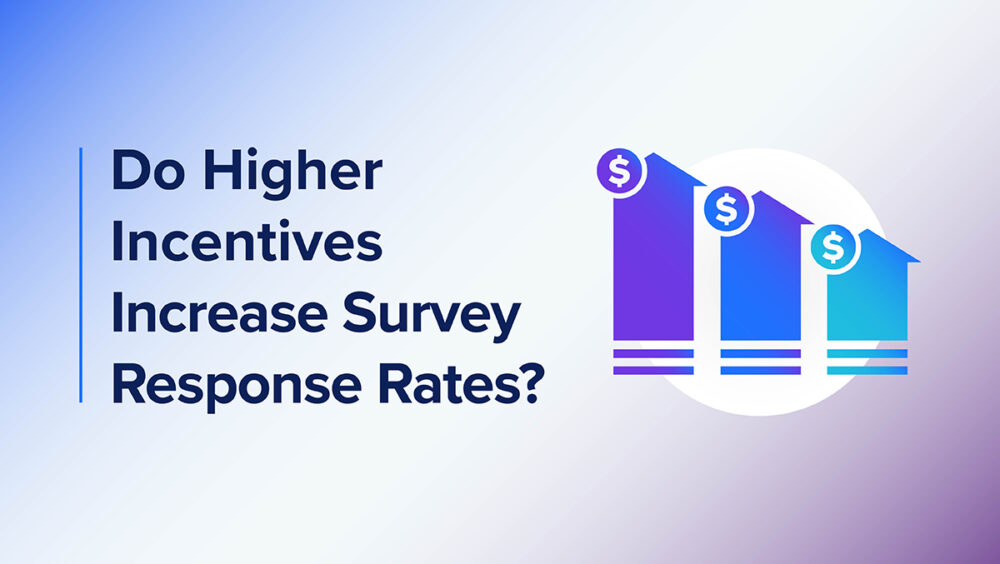Market researchers have long assumed that higher incentives increase survey response rates. But what if conventional wisdom is wrong?
With research budgets under pressure and response rates declining, this assumption could be costing teams both money and data quality.
EveryAnswer and Virtual Incentives partnered to test the real-world impact of monetary and non-monetary incentives on survey participation in digital recruitment.
The collaboration aimed to answer two fundamental questions: which incentives actually motivate people to start and complete surveys, and does effectiveness depend on context, topic, amount, and audience?
The research challenged core assumptions about incentive strategy, showing that context often matters more than dollar amounts.
The Problem: Do Higher Incentives Really Boost Survey Response Rates?
Direct online recruitment offers an opportunity to drive survey participation in non-panel settings. But recruiting success varies by topic, and researchers lack clear guidance on effective incentive strategies.
EveryAnswer, a digital advertising platform that helps researchers recruit respondents directly with specialized ads and quality controls, and Virtual Incentives recognized this challenge.
Virtual Incentives had previous research showing panel respondents don’t expect large payments, but critical questions remained:
- What incentives actually work for different survey topics in direct recruitment?
- How do monetary and non-monetary incentives compare when there’s no established relationship between participants and the platform?
Both companies realized they needed to test whether traditional thinking about incentives applied to direct online recruitment, where trust is lower.
The Solution: Testing Incentive Effectiveness Through Controlled Digital Experiments
EveryAnswer and Virtual Incentives partnered to test the real-world impact of monetary and non-monetary incentives on survey participation.
The partnership combined EveryAnswer’s controlled sampling methodology (individual unique links, targeted ads, data quality checks) with Virtual Incentives’ diverse reward platform for seamless incentive delivery. This test took place in two waves:
Wave 1: Comprehensive Testing (8,597 participants)
- Recruited participants via digital advertising in WA, stratified by age and location
- Randomized survey assignments across topics (politics, housing, health insurance, telecom) and incentive types (gift card, donation, none)
- Tested incentive amounts from $1-$20
- Tracked complete participant funnel from ad view to survey completion
Wave 2: Focused Analysis (1,080 start page visits)
- Enhanced landing pages to make incentive amounts and types more prominent and measurable
- Concentrated on single topic (housing) to isolate incentive effects
- Added $3 gift card option based on Wave 1 insights
- Analyzed completion patterns across demographic segments
Together, the companies uncovered surprising truths about what actually drives survey participation, and what doesn’t.
The Results: Context and Strategy Outperform Higher Dollar Amounts
The research revealed that survey participation follows more complex patterns than “bigger incentives equal better response.” Key data points include:
- Politics surveys achieved 38% start rates and 60% completion rates
- Telecom surveys managed only 10% starts and 30% completion
- Older respondents (65+) showed 32% start rates versus 12% for 18-29 age group
- $3 gift cards delivered the strongest completion rate improvements
- Higher incentives ($10+) showed diminishing returns and sometimes triggered skepticism about legitimacy
- Male participants demonstrated greater responsiveness to incentive amounts
- Incentives improved completion rates but didn’t significantly increase survey starts
The findings challenge conventional incentive wisdom. Incentives had the most promise with younger respondents and male respondents. High gift card amounts and cash offers may provoke skepticism in online settings where scams are prevalent.
Willingness to participate was heavily topic dependent. The research showed that thoughtful, context-appropriate incentives often outperform simply increasing dollar amounts.
For research teams, this means rethinking budget allocation and strategy. Instead of defaulting to higher incentive amounts, teams can achieve better completion rates while spending less by focusing on the $3-5 range for gift cards.
Teams can also optimize topic promotion based on subject matter. Popular topics like politics or entertainment perform well when highlighted in recruitment ads, while sensitive topics like healthcare or finances may see better results when introduced after the survey starts.
Lastly, when recruiting younger audiences or males, making incentive offers more prominent can improve response, as these groups demonstrated greater responsiveness to incentives.
“This collaboration gave us evidence that incentives aren’t one-size-fits-all. The right mix of type, amount, and context can make the difference between a drop-off and a completed survey.” – Virtual Incentives & EveryAnswer Research Team
Ready to Optimize Your Incentive Strategy?
Looking to deliver smarter, more secure incentives that drive real engagement? This research provides a blueprint for optimizing both participation rates and research budgets through evidence-based incentive strategies. Let’s connect about applying these insights to your survey operations.
